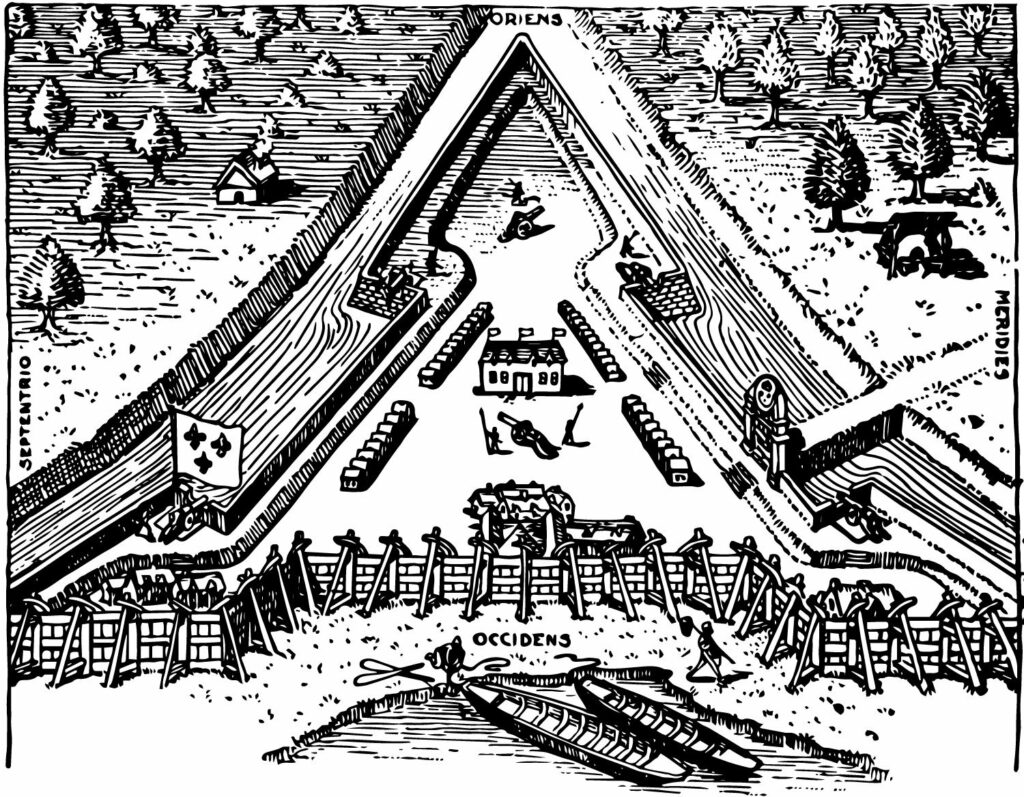The Spanish had long planned on becoming the dominant force in the colonization of Florida from the late 1400s through to the 1500s. Juan Ponce de Leon, a Spanish conquistador, and explorer, are widely known to have led the very first European expedition to Florida. After traveling to the New World with Christopher Columbus in 1493, he continued to build his naval experience, becoming a top military official and eventually landing somewhere on Florida’s East Coast in 1513. His expedition followed the Atlantic Coast to the Florida Keys, along the Gulf Coast, perhaps as far as Apalachee Bay on the Western Coast of Florida.
St. Augustine was established in 1565 by Spanish explorer Pedro Menendez de Aviles on September 8th, 1565, who also went on to become the first governor of Florida. Originally named “San Augustin,” the site was spotted from his ships on August 28th, the feast day of St. Augustine. The establishment of this city helped to further Spanish dominance in the area.
Early French Huguenot Settlements
However, the Spanish were not the only ones with notions of setting up colonies in Florida. In February 1562, a French Huguenot expedition led by Jean Ribault landed at the May River, known as the St. John’s River today. Venturing north, he and twenty-eight of his troops developed a settlement known as Charlesfort, on modern-day Parris Island in South Carolina.
After establishing the colony, Ribault returned to Europe to gather supplies for the new settlement. However, on his return, he was imprisoned in England under charges of espionage-related to the Wars of Religion, which were ongoing in Europe at the time. Unable to return to Florida, Charlesfort never had the supplies or leadership to survive and was eventually abandoned by all but one of the colonists. The deserters sailed back to Europe by open boat and were reduced to cannibalism before the survivors were finally rescued in British waters.
French Huguenots Establish Fort Caroline
As Jean Ribault was still in prison in England, his second in command, Rene Goulainie de Laudonniere, was appointed to command a return expedition to Florida to seek a safe haven for French Huguenots. Arriving at the mouth of the River May, on June 22nd, 1564, he founded Fort Caroline, named after King Charles IX of France. While the precise site of Fort Caroline is not known, it’s thought it was located on the southern bank of the St. John’s River in the vicinity of the present-day Fort Caroline National Memorial.
Fort Caroline was not a very successful establishment for the first year, falling victim to a lack of food and desertion from some French occupants. The colonists had to rely heavily on the local Timucua Indians, who welcomed them with open arms and helped the French as much as possible, allowing them to travel freely across their territory. However, those colonists who had deserted Fort Caroline began to raise Timucua settlements, which, in turn, ruined relationships between the French and the locals.
The problems in Fort Caroline came to the attention of the Spanish authorities, that deemed the French presence to challenge their position in the area. What’s more, the devoutly Catholic Spaniards could not accept the French Huguenots, who were Protestants, to be an influence in a region where they were trying to assert their beliefs.
Ribault And Menendez de Aviles Clash
Released from British custody in June 1565, Jean Ribault, along with a fleet of soldiers, settlers, and supplies, returned to take command of Fort Caroline. At the same time, Spanish explorer, and newly appointed Governor of Florida, Pedro Menendez de Aviles, disembarked from Spain under orders to remove the French Huguenots from Fort Caroline and to destroy the French outpost.
Menendez and his men arrived within days of Ribault and his fleet arriving. A brief battle, between the French and the Spanish fleets, resulted in the Spanish retreating thirty-five miles south, where they established St. Augustine. Ribault followed the Spanish but, unfortunately, got caught in a violent storm that destroyed several of his ships and killed countless troops.
With much of Jean Ribault’s fleet either underwater or run aground on sandbanks just south of St. Augustine, Pedro Menendez de Aviles and his crew took their opportunity to attack Fort Caroline.
Fort Caroline Is Destroyed By Menendez And His Men
As the storm that had destroyed Ribault’s fleet rallied on, Menendez marched his troops north overland to lead a surprise attack on the French settlement. The Spaniards defeated the 200 to 250 strong garrison of French Huguenot troops, sparing only fifty women and children, massacring almost everyone else.
After taking over Fort Caroline and killing the French Huguenot colonizers, Menendez went in search of any French that survived the storm, including Jean Ribault. Although the shipwreck survivors surrendered when they were found, Menendez and his men brutally murdered them in what has become known as the “Massacre at Matanzas Inlet”. The brutality of the killings was so brutal that there was a sense of shock when the stories traveled back to Europe, despite the fact that Europe was in the midst of an incredibly bloody era of religious conflict.
With the French Huguenot threat removed, the Spanish burned Fort Caroline to the ground, destroying it completely and rebuilding their own fort on the same site. However, a French force led by Dominique de Gourgues captured and burned the fort down again in April 1568. They also slaughtered all of the Spanish they captured in retaliation for the Massacre at Matanzas Inlet. Despite rebuilding the fort, the Spanish abandoned the structure the following year.
